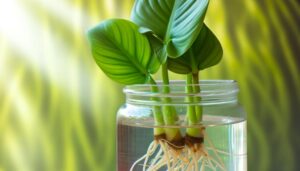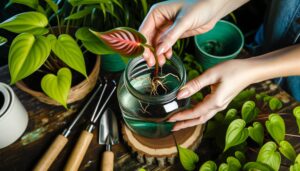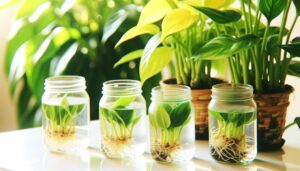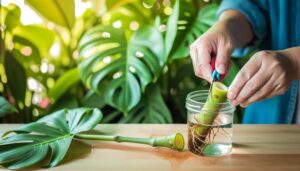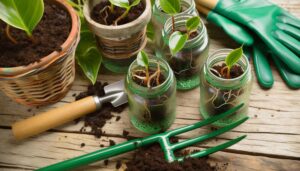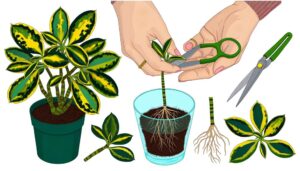How to Propagate Self Heading Philodendron? Easy Methods!
To propagate a self-heading philodendron, start with sterilized, sharp pruning shears and rooting hormone. Select a healthy, pest-free parent plant and avoid fertilizing it a week before.
Cut a 4-6 inch stem with several nodes at a 45-degree angle and remove lower leaves. Submerge the cut end in clean water or a suitable rooting medium, ensuring the nodes are immersed.
Maintain temperatures between 70-75°F and provide bright, indirect light with high humidity. Transplant rooted cuttings into a well-draining soil mix and monitor for pests.
Further details will enhance your propagation success.
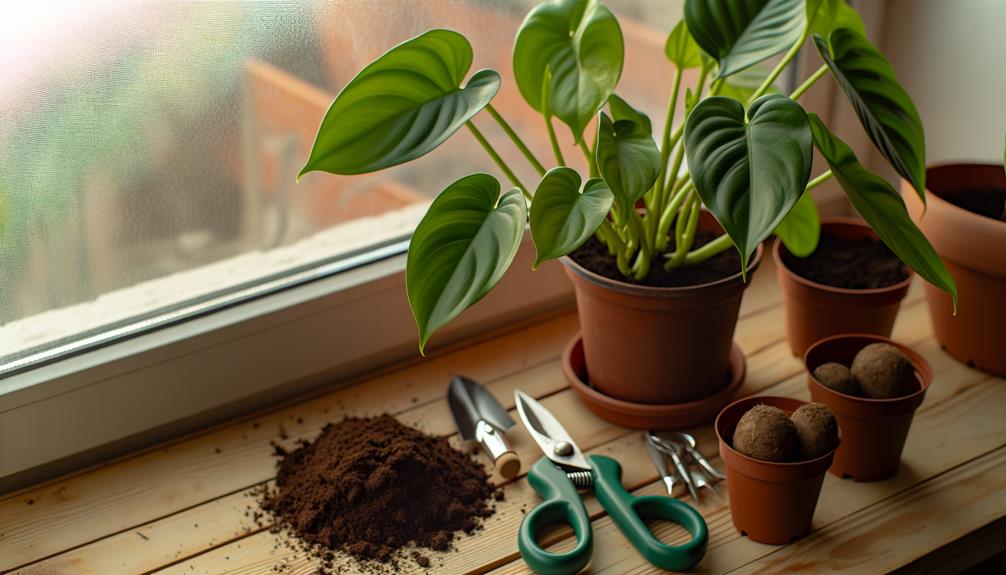
Key Takeaways
- Use high-quality, sharp, and sterilized pruning shears to take a 4-6 inch cutting with nodes.
- Ensure the parent plant is healthy, well-hydrated, and pest-free before taking cuttings.
- Remove lower leaves and make a 45-degree cut to increase rooting surface.
- Submerge the cut end in water or rooting medium and maintain 70-75°F with high humidity.
- Transplant rooted cuttings into well-draining soil mix and provide bright, indirect light.
Choosing the Right Tools
Choosing the right tools is vital for the successful propagation of self-heading philodendrons, as it ensures both efficiency and the health of the plant. High-quality, sharp pruning shears are necessary to make clean cuts, minimizing damage and promoting quicker healing.
A sterile blade or knife is also essential to prevent pathogen transmission. Additionally, a rooting hormone can enhance root development and increase propagation success rates.
It is recommended to use clean containers filled with a well-draining potting mix to provide an ideal environment for root growth. A misting bottle maintains proper moisture levels without waterlogging.
Preparing the Parent Plant
Before initiating propagation, it is important to confirm the parent plant is healthy and free of pests and diseases. Conduct a thorough examination, focusing on leaf coloration, structural integrity, and overall vigor.
Verify the plant is well-hydrated but not waterlogged, and that it has been receiving adequate light. Also, avoid fertilizing the plant for at least one week before propagation to prevent stress.
| Inspection Area | Key Indicators |
|---|---|
| Leaf Color | Vibrant green, no yellowing |
| Structural Integrity | Firm, upright stems |
| Pest Presence | Absence of visible pests/eggs |
| Hydration Level | Moist soil, not soggy |
Taking the Cuttings
After confirming the health and readiness of the parent plant, proceed by selecting a suitable stem for cutting, ensuring it is at least 4-6 inches long and contains several nodes.
Utilize sterilized pruning shears or a sharp knife to make a clean cut just below a node. This node is critical as it contains the meristematic tissue necessary for root development.
Carefully remove any leaves around the lower nodes to reduce transpiration and potential rot during the rooting process. It is recommended to make the cut at a 45-degree angle to increase the surface area for rooting.
Immediately place the cutting in a clean, moist environment to prevent desiccation and prepare it for the next stage of propagation.
Rooting the Cuttings
To start the rooting process, submerge the cut end of the philodendron cutting into a container filled with clean water or a well-draining rooting medium, making sure the nodes are fully immersed. This step is vital for promoting root development. It is essential to maintain ideal conditions for the cuttings to encourage successful rooting.
- Temperature: Keep the environment warm, ideally between 70-75°F (21-24°C).
- Light: Provide bright, indirect light to avoid scorching the delicate cuttings.
- Humidity: Maintain high humidity levels around the cuttings to prevent desiccation.
- Water Quality: Use distilled or filtered water to avoid contaminant-induced stress.
- Sterility: Guarantee all tools and containers are sterilized to prevent fungal or bacterial infections.
These factors collectively enhance the chances of successful propagation.
Transplanting and Care
Once the cuttings have developed a robust root system, they are ready to be transplanted into a suitable potting mix to guarantee continued growth and stability.
Select a well-draining soil mix rich in organic matter, such as a blend of peat moss, perlite, and compost. Confirm the pot has ample drainage holes to prevent waterlogging, which can lead to root rot.
Position the cutting in the center, backfill with soil, and water thoroughly to settle the mix around the roots. Place the pot in a location with bright, indirect light, maintaining consistent moisture without overwatering.
Regularly monitor for pests and provide occasional feeding with a balanced, water-soluble fertilizer to support optimal growth and health.
Conclusion
To sum up, the propagation of self-heading philodendrons, similar to the meticulous artistry of a skilled botanist, requires precision and care.
Selecting suitable tools, preparing the parent plant, executing precise cuttings, and ensuring ideal rooting conditions are paramount.
Successful transplantation and subsequent care will yield thriving specimens.
By following these detailed steps, one perpetuates the cycle of life, mirroring nature’s inherent resilience and beauty, similar to the ever-renewing growth observed in lush, untouched forests.

